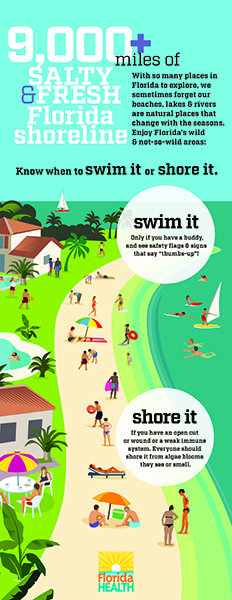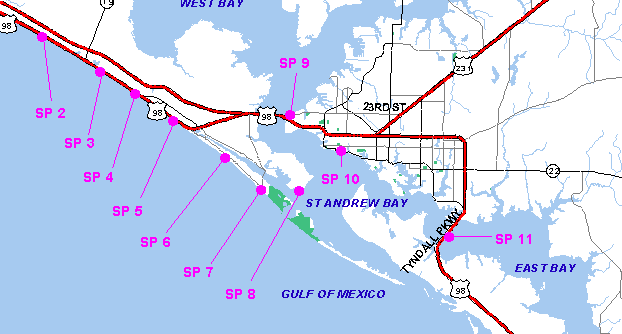It's a New Day in Public Health.
The Florida Department of Health works to protect, promote, and improve the health of all people in Florida through integrated state, county, and community efforts.
Beach Safety
Contact Us
- 850-481-4812
- DLCHD03Environmental@flhealth.gov
-
Fax
850-747-5995 -
Mailing Address
597 W 11th Street
Panama City, FL 32401

Florida Healthy Beaches Program

Beach Water Quality, Program Overview
In 1998, five of Florida's coastal counties began monitoring for enterococci bacteria under a grant-funded pilot program. By the beginning of 2000, 11 Florida counties were participating in the program, which continued through July 2000.
In August 2000, the Beach Water Sampling Program was extended to 30 of Florida's coastal counties through state legislation (Senate Bill 1412 and House Bill 2145) and funding. In addition, sampling under the new program include fecal coliform as well as enterococci bacteria. The rationale for selecting these two bacteria for analysis and implications of the sampling results are described below. In August 2002, the beach water sampling program also began collecting water samples on a weekly basis with additional funding from U.S. EPA.
Changes to funding levels in 2011 resulted in a return to bi-weekly sampling, the elimination of all fecal coliform sampling, and a reduction of the number of sample locations. Since enterococcus bacteria are indicators of the same types of pollution as fecal coliform bacteria, this did not affect the safety of Florida Residents. At this time sampling in the northern parts of the state was also suspended during the winter months, November through February.
Health Implications
Enterococci are enteric bacteria that normally inhabit the intestinal tract of humans and animals. The presence of enteric bacteria can be an indication of fecal pollution, which may come from stormwater runoff, pets and wildlife, and human sewage. If they are present in high concentrations in recreational waters and are ingested while swimming or enter the skin through a cut or sore, they may cause human disease, infections or rashes.
The statewide testing program tests for enterococci, which the United States Environmental Protection Agency (EPA) opens in new window has recommended states adopt as a saltwater quality indicator. According to studies conducted by the EPA, enterococci have a greater correlation with swimming-associated gastrointestinal illness in both marine and fresh waters than other bacterial indicator organisms, and are less likely to "die off" in saltwater. If an enterococci result were observed to exceed 70 colony forming units per 100 milliliters of beach water sampled and a resampling result also exceeds this value, then an "Advisory" would be issued for the sampling site.
Florida Healthy Beaches Program Categories are:
Good = 0-35 Enterococci per 100 milliliters of marine water
Moderate = 36-70 Enterococci per 100 milliliters of marine water
Poor = 71 or greater Enterococci per 100 milliliters of marine water
_FloridaHealth_gov:environmental-health/beach-water-quality/index
Vibrio Vulnificus Bacteria
Department information for Vibrio vulnificus
Information about Necrotizing Fascitis
- Necrotizing fasciitis (many times called “flesh eating bacteria” by the media) is caused by more than one type of bacteria. Several bacteria, common in our environment can cause this condition – the most common cause of necrotizing fasciitis is Group A strep.
- People do not “catch” necrotizing fasciitis; it is a complication or symptom of a bacterial infection that has not been promptly or properly treated.
- Sometimes people call Vibrio vulnificus the “flesh eating bacteria.” Vibrio vulnificus is a naturally occurring bacteria found in warm salty waters such as the Gulf of Mexico and surrounding bays. Concentrations of this bacteria are higher when the water is warmer.
- Necrotizing fasciitis and severe infections with Vibrio vulnificus are rare. These infections can be treated with antibiotics and sometimes require surgery to remove damaged tissue.
- Rapid diagnosis is the key to effective treatment and recovery.
- If you are healthy with a strong immune system, your chances of developing or having complications due to this condition are extremely low.
How to Reduce Your Risk of Exposure
- The Centers for Disease Control and Prevention (CDC) encourages all people to avoid open bodies of water (such as the Gulf), pools and hot tubs with breaks in the skin. These can include cuts and scrapes, burns, insect bites, puncture wounds, or surgical wounds.
- The Florida Department of Health and the CDC encourage good wound care, as the best way to prevent any bacterial skin infection. Keep open wounds covered with clean, dry bandages until healed and don't delay first aid of even minor, non-infected wounds like blisters, scrapes or any break in the skin.
- You can prevent these types of infections when at the beach or bay by:
- Avoiding walking, sitting, or swimming in Gulf or bay waters with open wounds,
- Properly cleaning and treating wounds after:
- Accidentally exposing a wound to Gulf or bay waters,
- Getting an injury injured while in the water, or
- Getting an injury while cleaning or handling seafood.
- Seeking medical treatment immediately if you develop signs or symptoms of an infection (redness, swelling, fever, severe pain in area of red or swollen skin) near or around a wound.
- People with the greatest risk of exposure to bacteria in water bodies, pools or hots tubs are very young children, the elderly (>64 years old), and people with chronic diseases and/or weaken immune systems since their ability to fight off infection can be limited by disease or age. This doesn’t mean you can’t enjoy the Gulf, bay, pools or hot tubs. Rather you are encouraged to monitor your overall health and skin condition for possible signs of infection.
- It is important for individuals receiving medical care to let their doctor know of any recent exposure to Gulf or bay waters, pools or hot tubs. Timely treatment is necessary to prevent serious complications.
Red Tide
Red tide may cause coughing, sneezing and water eyes. People with chronic respiratory problems, should avoid areas with active red tide. Seafood sold in restaurants, hotels, grocery stores are markets is safe to eat.
For information on health effects related to Ride Tide, please see the Department of Health’s Aquatic Toxins program website.
For the latest Red Tide testing results, please go to the Fish and Wildlife Conservation Commission Website.
For questions and health concerns related to red tide call the Florida Poison Control Center at 1-800-222-1222.
For additional information, visit the Florida Fish and Wildlife Conservation Comission's Red Tide page by clicking the link here: https://myfwc.com/research/redtide/statewide/. (Please note, clicking this link will open in a new window and take you outside of DOH-Bay's website.)



Connect with DOH